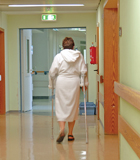
Increasingly, dementia and other conditions that might lead to wandering or safety issues are challenging long-term care operators and their potential clients’ families. Experts offer guidance on how to convince family members, and residents themselves, that a facility’s resident safety systems are up to snuff.
1
When possible, providers should engage family members to make them advocates of the facility and its equipment. Operators can educate family members with brochures and various forms of information about systems.
“When a senior resident is resistant to wearing a wandering management bracelet or emergency call button, it is always helpful to find an advocate among family members,” notes Kathie Vick, marketing manager at RF Technologies.
2
Make sure employees are well educated in order to best disseminate information to residents’ families.
“A resident’s quality of life is only as comfortable as the caregiver’s knowledge and expertise,” Vick adds.
3
Savvy operators have posted information about their safety systems on their websites, notes Intelligent InSites President and CEO Mark Rheault. This not only helps to disseminate information to family members and others, but it also allows a provider to distance itself from competitors, he adds. In addition, extra background information should be provided in orientation kits and other ancillary materials.
4
Don’t forget that actions speak louder than words.
“As seeing is believing, the best way to convince residents and family members that your community has the right safety system in place is showing them a live presentation of the system itself,” Rheault says.
He advises that providers physically show what happens when a resident activates a safety system, on purpose or not. Show what happens when monitors or notification systems are triggered. Point out how notifications can escalate in urgency, or broaden in scope.
5
Along with demonstrating the equipment, Robert Wilowski, owner and president of Cord-Mate Inc., says providers should be able to show records illustrating successful use and past good outcomes. Testimonials from satisfied current or past clients (and their family members) also are helpful, Wilowski notes. Explain equipment maintenance and testing procedures, he adds.
6
Making sure residents and family members know the full range of systems’ capabilities is always a challenge—one that must be balanced against intimidating the potential client, experts noted.
“Providers should convey that wireless technology affords itself to encompass the entire campus, therefore enabling residents freedom and mobility, while at the same time providing safety and security through the use of monitored devices,” notes Mike MacLeod, co-founder of Status Solutions.
Be sure to point out that better technology should improve staff efficiency and productivity, allowing caregivers to provide better direct care to residents, he adds.
7
Keeping the resident and his or her care front and center is the ultimate goal, reminds Eric Hunzeker, director of Direct Channel Sales for Stanley Healthcare Solutions.
“It’s a tough reality to face when you’re told your parent or another loved one in long-term care has been deemed a ‘fall risk’ and requires a bed and/or chair exit alarm,” Hunzeker notes. He advises providers cover three important topics with family members.
First, be sure to tell how you arrived at your risk assessment, how the care plan considers various factors, and when the resident will be re-evaluated. Also, be frank about what other risk factors might be, or come, into play. One risk factor often is the harbinger of others, he explains.
Finally, be clear about the devices and systems you use. Ensure they’re registered with the U.S. Food and Drug Administration, he adds.
“Be compassionate, but be straightforward,” he advises. “This could be a very important time in their loved one’s life.”
From the August 01, 2010 Issue of McKnight's Long-Term Care News




